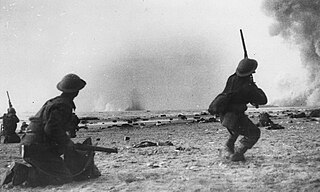
The Battle of Dunkirk was fought around the French port of Dunkirk (Dunkerque) during the Second World War, between the Allies and Nazi Germany. As the Allies were losing the Battle of France on the Western Front, the Battle of Dunkirk was the defence and evacuation of British and other Allied forces to Britain from 26 May to 4 June 1940.

The First Battle of Ypres was a battle of the First World War, fought on the Western Front around Ypres, in West Flanders, Belgium. The battle was part of the First Battle of Flanders, in which German, French, Belgian armies and the British Expeditionary Force (BEF) fought from Arras in France to Nieuwpoort (Nieuport) on the Belgian coast, from 10 October to mid-November. The battles at Ypres began at the end of the Race to the Sea, reciprocal attempts by the German and Franco-British armies to advance past the northern flank of their opponents. North of Ypres, the fighting continued in the Battle of the Yser (16–31 October), between the German 4th Army, the Belgian army and French marines.
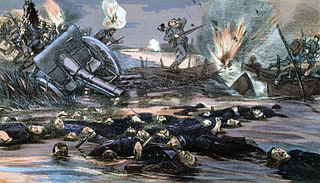
The Battle of the Yser was a battle of the First World War that took place in October 1914 between the towns of Nieuwpoort and Diksmuide, along a 35 km (22 mi) stretch of the Yser River and the Yperlee Canal, in Belgium. The front line was held by a large Belgian force, which halted the German advance in a costly defensive battle.
A dirk is a long-bladed thrusting dagger. Historically, it gained its name from the Highland dirk where it was a personal weapon of officers engaged in naval hand-to-hand combat during the Age of Sail as well as the personal sidearm of Highlanders. It was also the traditional sidearm of the Highland Clansman and later used by the officers, pipers, and drummers of Scottish Highland regiments around 1725 to 1800 and by Japanese naval officers.

Captain 3rd Rank Valery Mikhailovich Sablin was a Soviet Navy officer and a member of the Communist Party. In November 1975, he noticed the rampant corruption and stagnation in Leonid Brezhnev's Soviet Union, he then led a mutiny on the Soviet anti-submarine frigate, Storozhevoy in the hope of starting a Leninist political revolution in the Soviet Union. His mutiny failed and he was executed for treason nine months later.
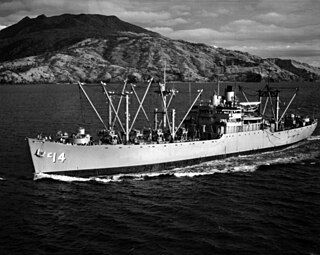
USS Firedrake (AE-14) was a Mount Hood-class ammunition ship in service with the United States Navy from 1944 to 1946 and from 1951 to 1971. She was scrapped in 1978.

Émile Henry Muselier was a French admiral who led the Free French Naval Forces during World War II. He was responsible for the idea of distinguishing his fleet from that of Vichy France by adopting the Cross of Lorraine, which later became the emblem of all of the Free French. After entering the French Naval Academy in 1899, he embarked on a brilliant and eventful military career. He ran unsuccessfully in the legislative elections of 1946 as vice-president of the Rally of Republican Lefts and then entered private life as a consulting engineer before his retirement in 1960. He is buried in the cemetery of St. Pierre, at Marseilles.
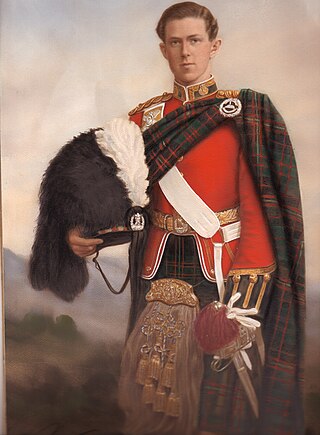
Major Donald Fraser Callander OBE MC & Bar was one of the last serving British Army officers to lead his men into battle wearing the kilt.

Operation Hush was a British plan to make amphibious landings on the Belgian coast in 1917 during the First World War, supported by an attack from Nieuwpoort and the Yser bridgehead, positions which were a legacy of the Battle of the Yser in 1914. Several plans were considered in 1915 and 1916, then shelved due to operations elsewhere. Operation Hush was intended to begin when the Third Battle of Ypres, the main offensive at Ypres, had advanced to Roulers, Koekelare and Thourout, linked by advances by the French and Belgian armies in between.

HMS Firedrake was an F-class destroyer built for the Royal Navy during the early 1930s. Although assigned to the Home Fleet upon completion, the ship was attached to the Mediterranean Fleet in 1935–36 during the Abyssinia Crisis. During the Spanish Civil War of 1936–39, she spent much time in Spanish waters, enforcing the arms blockade imposed by Britain and France on both sides of the conflict.
The 44th Infantry Brigade was an infantry brigade of the British Army that saw active service in both the First and the Second World Wars, and served with the 15th (Scottish) Infantry Division.
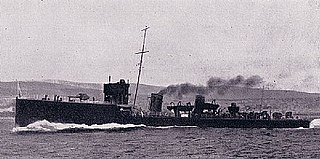
HMS Lurcher was a modified Acheron-class destroyer, named after the lurcher-type dog, and the fifth ship of the Royal Navy to bear the name; when new she was the fastest ship in the Royal Navy.

HMS Firedrake was a modified Acheron-class destroyer, named after the fire-breathing dragon of Anglo-Saxon mythology, and the sixth ship of the Royal Navy to bear the name.
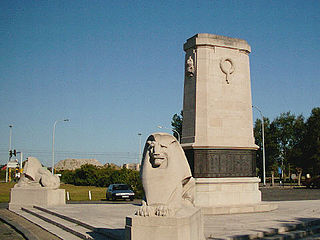
The British Nieuport Memorial is a First World War memorial, located in the Belgian port city of Nieuwpoort, which is at the mouth of the River Yser. The memorial lists 547 names of British officers and men with no known grave who were killed in the Siege of Antwerp in 1914 or in the defence of this part of the Western Front from June to November 1917. Those that fought in 1914 were members of the Royal Naval Division. The fighting in 1917, when XV Corps defended the line from Sint-Joris to the sea, included the German use of chemical weapons such as mustard gas and Blue Cross.

The German invasion of Belgium was a military campaign which began on 4 August 1914. On 24 July, the Belgian government had announced that if war came it would uphold its neutrality. The Belgian government mobilised its armed forces on 31 July and a state of heightened alert was proclaimed in Germany. On 2 August, the German government sent an ultimatum to Belgium, demanding passage through the country and German forces invaded Luxembourg. Two days later, the Belgian government refused the German demands and the British government guaranteed military support to Belgium. The German government declared war on Belgium on 4 August; German troops crossed the border and began the Battle of Liège.
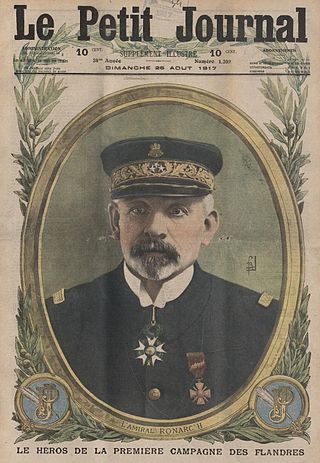
Pierre-Alexis Ronarc'h was a French sailor and admiral, born on 22 November 1865 in Quimper and died 1 April 1940 in Paris.

The Yser Front, sometimes termed the West Flemish Front in British writing, was a section of the Western Front during World War I held by Belgian troops from October 1914 until 1918. The front ran along the Yser river (IJzer) and Yser Canal (Ieperlee) in the far north-west of Belgium and defended a small strip of the country which remained unoccupied. The front was established following the Battle of the Yser in October 1914, when the Belgian army succeeded in stopping the German advance after months of retreat and remained largely static for the duration of the war.
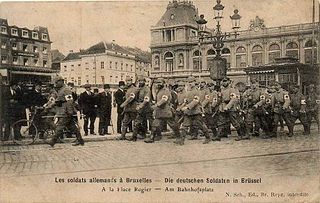
The German occupation of Belgium of World War I was a military occupation of Belgium by the forces of the German Empire between 1914 and 1918. Beginning in August 1914 with the invasion of neutral Belgium, the country was almost completely overrun by German troops before the winter of the same year as the Allied forces withdrew westwards. The Belgian government went into exile, while King Albert I and the Belgian Army continued to fight on a section of the Western Front. Under the German military, Belgium was divided into three separate administrative zones. The majority of the country fell within the General Government, a formal occupation administration ruled by a German general, while the others, closer to the front line, came under more repressive direct military rule.
The Brigade des Fusiliers Marins was a unit of the French Navy which fought alongside the Belgium Army in 1914-1915 and which held their ground as they suffered heavy losses in October 1914 at Diksmuide to halt the advance of the German army and protect Dunkirk.

Hendrik Geeraert was a Belgian folk hero who, during the interwar period, came to symbolize the Belgian resistance movement against the German forces in World War I. He became famous among Belgian soldiers in 1914 after the Battle of the Yser where he, serving as a Nieuwpoort skipper, opened the sluices of the Yser River, flooding the polders and bringing the German advance to a halt.

















